Savory Polenta Breakfast Bowls with Roasted Veggies
Ingredients
- 1 cup polenta coarse cornmeal, not instant
- 4 cups vegetable broth or water
- ½ cup grated Parmesan cheese plus more for serving
- 2 tbsp butter unsalted
- 1 tsp salt divided
- 1 medium zucchini diced
- 1 medium bell pepper red or yellow, diced
- 1 pint cherry tomatoes halved
- 1 small red onion diced
- 8 oz mushrooms sliced
- 3 cloves garlic minced
- 2 tbsp olive oil
- 1 tbsp balsamic vinegar
- 1 tsp dried Italian herbs
- 4 large eggs
- ¼ cup fresh herbs chopped (basil, parsley, or chives)
- red pepper flakes to taste (optional)
- freshly ground black pepper to taste
Instructions
- Preheat oven to 425°F (220°C). Line a large baking sheet with parchment paper.
- In a large bowl, toss the zucchini, bell pepper, cherry tomatoes, red onion, mushrooms, and garlic with olive oil, balsamic vinegar, dried Italian herbs, 1/2 teaspoon salt, and black pepper. Spread in a single layer on the prepared baking sheet.
- Roast vegetables for 20-25 minutes, stirring halfway through, until tender and slightly caramelized.
- While vegetables are roasting, prepare the polenta. In a large saucepan, bring the vegetable broth or water to a boil. Slowly whisk in the polenta, stirring constantly to prevent lumps.
- Reduce heat to low and simmer, stirring frequently, for about 20-25 minutes until the polenta is thick and creamy. If it becomes too thick, add a little more broth or water.
- Remove polenta from heat and stir in the Parmesan cheese, butter, and remaining 1/2 teaspoon salt. Cover to keep warm.
- In a non-stick skillet, cook eggs to your preference (sunny-side up or over-easy recommended for runny yolks).
- To serve, divide the polenta among four bowls. Top each with a portion of roasted vegetables and a cooked egg. Garnish with additional Parmesan cheese, fresh herbs, and red pepper flakes if desired.
Notes
Starting your day with a warm, hearty meal is comforting. Imagine waking up to the smell of roasted veggies and creamy polenta. It’s more than food; it’s a way to wake up your senses and start the day right.
Savory polenta is a staple in Italian cuisine. It’s perfect for making delicious breakfast bowls that everyone will love. Each bite is not just filling; it’s also good for you.
Key Takeaways
- Savory polenta offers a creamy and comforting breakfast option.
- Roasted vegetables enhance the flavors and nutritional value of the dish.
- Polenta recipes can easily be customized to suit dietary preferences.
- A hearty breakfast bowl can set a positive tone for your day.
- Combining ingredients thoughtfully makes for a visually appealing meal.
Introduction to Savory Polenta
Polenta is a comforting dish in many kitchens, often found in Italian cuisine. It’s made from ground cornmeal and can be creamy or crispy. Learning what is polenta opens up many cooking options that can enhance your breakfast bowls.
What is Polenta?
This traditional dish is mainly made of coarse cornmeal and water. It’s boiled to create a thick, hearty base. Polenta can be served soft or cooled and then sliced for frying or grilling.
Nutritional Benefits of Polenta
Adding polenta to your meals brings many nutritional benefits of polenta. It’s full of carbohydrates, making it a great energy source. It’s also low in fat and has dietary fiber, which is good for your digestive health. Plus, it’s gluten-free, making it safe for those with gluten sensitivities or celiac disease.
Versatility in Cooking
Polenta is incredibly versatile. With a few polenta cooking tips, you can make it in many ways. Boiling makes it creamy, while oven cooking can give it a nice crust. Grilling or frying adds a unique flavor, allowing you to tailor it to your taste.
Ingredients for Savory Polenta Breakfast Bowls
Creating Savory Polenta Breakfast Bowls starts with the right ingredients. The mix of creamy polenta and fresh roasted veggies makes a great meal. Here’s what you need to start.
Essential Ingredients for Polenta
The heart of your bowl is quality polenta. Use coarse cornmeal for a thick texture. Adding chicken or veggie broth boosts the taste. A bit of milk makes it creamy, and Parmesan cheese adds a savory touch.
These elements create a perfect base for your bowls. They’re part of the Best Polenta Recipes.
Choosing Fresh Vegetables
Adding fresh veggies brings color and nutrition. Choose bright veggies like asparagus, mushrooms, and shallots. Seasonal produce is fresher and tastes better.
Look for firm veggies with bright colors. They show quality and ripeness. Fresh ingredients make your bowl more appealing.
Optional Toppings and Add-Ins
Make your bowls more exciting with optional toppings. Eggs, whether poached or fried, pair well with polenta. Fresh herbs like parsley or chives add flavor.
Avocado or sautéed greens add creaminess and nutrition. Try different toppings to make your dish unique. This way, you can customize it to your taste.

Preparing the Polenta
Making creamy polenta is all about mastering a few key techniques. These steps turn simple cornmeal into a rich, velvety dish. Whether you prefer traditional methods or quicker options, learning these will help you get the perfect consistency and flavor.
Cooking Techniques for Creamy Polenta
To make creamy polenta, start with high-quality cornmeal. The stovetop method gives the best texture. First, boil water or broth, then whisk in the cornmeal slowly, and lower the heat.
Whisking constantly is key to avoid lumps and get a smooth mix. If you’re short on time, instant polenta is a quick and creamy option.
Seasoning for Maximum Flavor
Seasoning boosts the flavor of creamy polenta. Start with salt and pepper, but don’t be afraid to try more. Add herbs like thyme or rosemary, or a bit of garlic powder for depth.
Stir in grated cheese or a splash of cream for extra richness. This will make the dish even more delicious.
Tips for Perfect Texture
Getting the right texture is important for polenta. Taste it as you go to find your perfect consistency. If it’s too thick, add more liquid.
For a creamy finish, let it rest for a few minutes before serving. This helps it absorb flavors and stay smooth and rich.
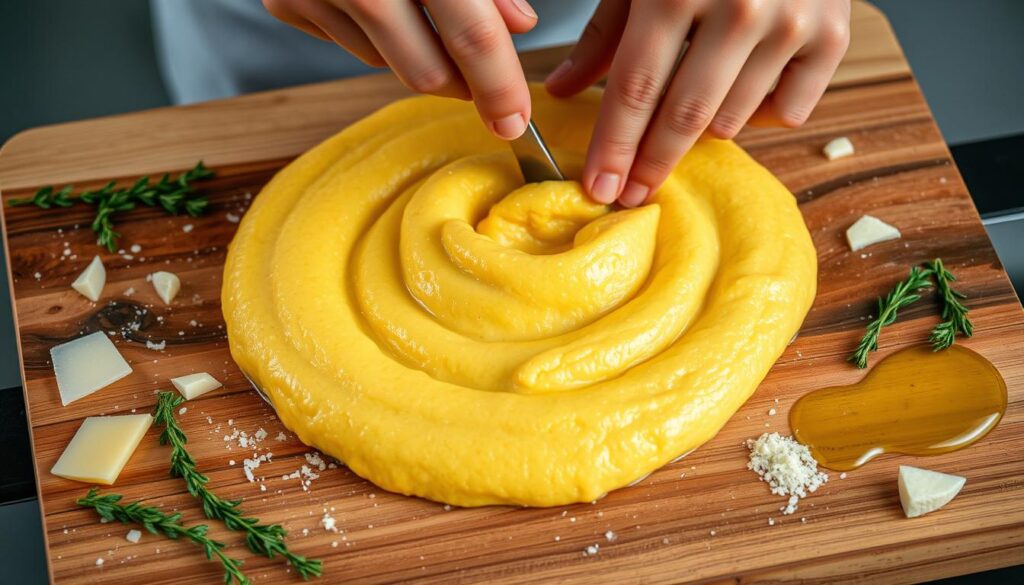
Roasting Vegetables
Roasting vegetables is key to making tasty breakfast bowls with creamy polenta. Picking the right veggies and mastering roasting can boost your meal’s taste. Here are top tips for roasting veggies that go great with polenta.
Best Vegetables for Roasting
Choose veggies that mix flavors and textures to make your dish better. Great picks include:
- Asparagus
- Bell peppers
- Cherry tomatoes
- Carrots
- Brussels sprouts
These veggies roast well and add color to your breakfast bowl.
Seasoning and Oil Recommendations
Right seasoning and oil can make your roasted veggies shine. A good mix is:
- Olive oil for a rich taste
- Garlic powder for depth
- Salt and pepper to taste
- Fresh herbs, like rosemary or thyme, for aroma
Using olive oil helps veggies caramelize, making them crispy yet tender.
Roasting Techniques and Timing
For the best results, follow these steps:
- Preheat your oven to 425°F.
- Spread veggies evenly on a baking sheet, avoiding overcrowding for even cooking.
- Toss them with your chosen seasoning and oil.
- Roast for 20-25 minutes, stirring halfway for even browning.
This timing makes veggies tender and keeps their colors bright, adding nutrition and flavor to your breakfast bowl.
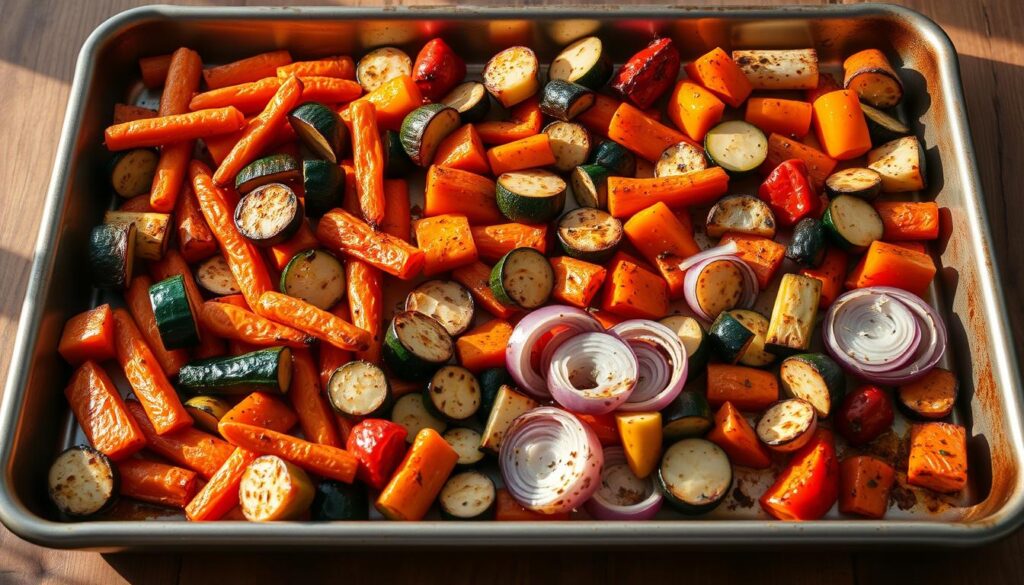
Assembling the Breakfast Bowls
When making your Savory Polenta Breakfast Bowls, focus on making them look good and taste great. Use layering to make each bowl both pretty and tasty. Follow tips on portion sizes and flavor mixing to make a meal that’s both pleasing to the eye and the taste buds.
Layering Techniques for Visual Appeal
Start with creamy polenta as the base. Then, add layers of colorful roasted veggies. Sprinkle some nuts or seeds for crunch. Top it off with a sauce or yogurt for extra flavor and visual appeal. This makes the dish not just look good but also taste amazing.
Portion Control Tips
It’s important to get the portion right for a healthy meal. Use a 1:1 ratio of polenta to veggies. A small amount of nuts or seeds adds crunch without too much. Serving sizes of about one cup are usually perfect, keeping your meal balanced and enjoyable.
Combining Flavors for a Delightful Meal
Mixing flavors is key to a great Savory Polenta dish. Try combining sweet, savory, and tangy tastes. For example, pair roasted red peppers with feta and balsamic vinegar. Add fresh herbs like basil or cilantro for a burst of freshness. This way, you can keep your meals exciting and full of flavor.
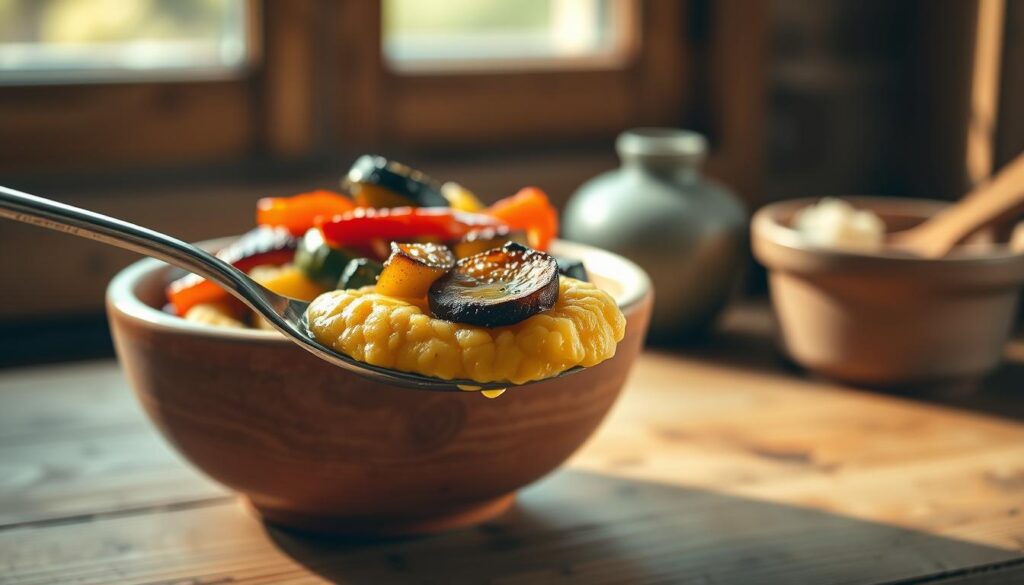
| Layer | Texture | Flavor Profile |
|---|---|---|
| Creamy Polenta | Smooth | Earthy, Mild |
| Roasted Vegetables | Crispy | Savory, Sweet |
| Crunchy Nuts/Seeds | Crunchy | Nutty, Rich |
| Sauce/Yogurt | Velvety | Tangy, Rich |
Customizing Your Savory Polenta Bowls
Creating your own Savory Polenta Bowls lets you get creative and make them your own. You can change the ingredients to fit your taste and dietary needs. This guide shows how to make your bowls stand out, with vegetarian and vegan choices, protein for energy, and spices to add flavor.
Vegetarian and Vegan Options
If you like plant-based meals, you can make your polenta bowls fit your diet. Try adding vegetables or legumes like:
- Chickpeas
- Lentils
- Grilled mushrooms
- Sautéed greens
These changes not only taste great but also add important nutrients. They help make your meal balanced and healthy.
Protein Additions for Extra Energy
To give your breakfast a boost, add protein sources. Good options include:
- Fried or poached eggs
- Tofu or tempeh
- Black beans or kidney beans
- Chicken or turkey slices
Adding these proteins keeps you energized all morning. It makes your Savory Polenta Ideas a great start to the day.
Spicing Up Your Bowl
To make your polenta bowl even better, try new spices. Add spices like:
- Chili flakes for heat
- Smoked paprika for a smoky touch
- Fresh herbs like basil or cilantro
These spices can take your dish to the next level. They let you discover new flavors and smells.
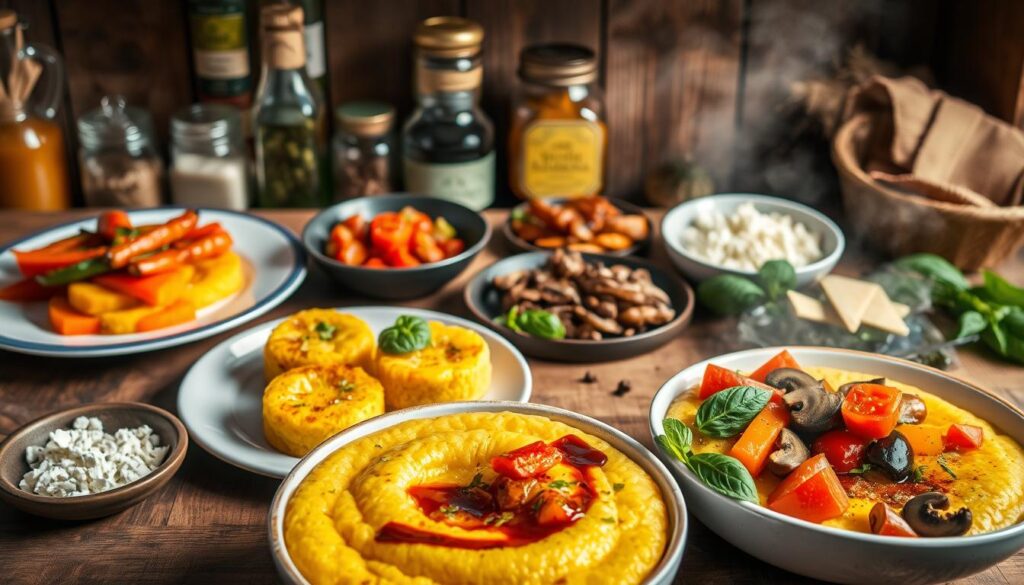
Serving Suggestions
Serving suggestions are key to enjoying savory polenta breakfast bowls. Pairing the right foods can make the meal even better. Knowing how much to serve helps for any occasion. Whether it’s a family breakfast or a brunch, here are some tips.
Ideal Breakfast Pairings
To make your polenta breakfast bowl special, try these pairings:
- Fresh fruits like berries, bananas, or citrus add a zesty flavor
- Greek yogurt with honey adds creaminess
- Avocado slices add nutrition
- Herbed cheese for a savory taste
These options not only taste great but also add freshness and protein to your morning.
Serving Sizes for Different Occasions
Knowing the right serving size is important for a satisfying meal. Here are some guidelines for different times:
| Occasion | Recommended Serving Size |
|---|---|
| Individual Breakfast | 1 cup of cooked polenta with 1/2 cup of roasted veggies |
| Family Breakfast | 2-3 cups of cooked polenta with 1 cup of roasted veggies per person |
| Brunch Gathering | 1 cup of polenta with a selection of 1/2 cup each of various toppings per person |
Making It a Family Meal
Involve your family in making the meal for a fun experience. Let everyone pick their toppings. This way, you all get to enjoy the dish together. Sharing a meal like this can create lasting memories.
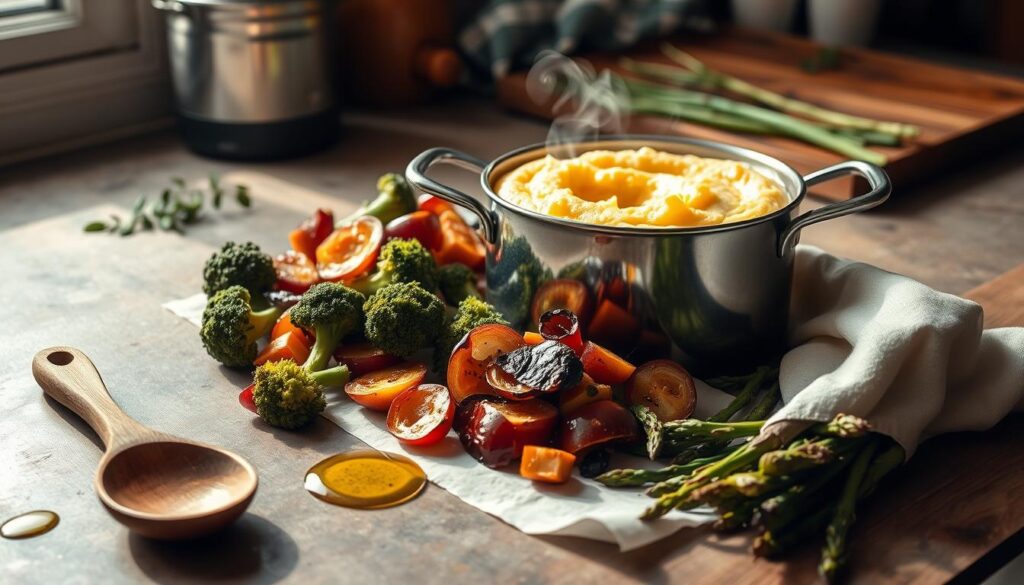
Storing Leftovers
Properly managing your leftover polenta and roasted vegetables can enhance both their longevity and flavor. Storing leftovers effectively ensures you make the most out of your meals. Follow these guidelines for refrigeration and reheating.
Best Practices for Refrigeration
To maintain the quality of your leftovers, split them into smaller portions before placing them in airtight containers. This practice not only helps with faster cooling but also makes it easier for you to reheat individual servings later. For polenta, you can spread it into a flat layer in a shallow dish to help it cool evenly. Store in the refrigerator for up to three days.
Reheating Tips for Optimal Taste
When you are ready to enjoy your leftovers, reheating properly can make a significant difference. Polenta can be reheated on the stove with a splash of water or broth to regain its creamy texture. For roasted vegetables, a quick toss in the oven for a few minutes can revive their crispness. Consider using a microwave for convenience, but be cautious as it may alter the texture.
Creative Ways to Use Leftover Polenta
Storing leftovers doesn’t have to be mundane. There are many Creative Ways to Use Leftover Polenta that can inspire your next meal. Try slicing leftover polenta into sticks, coating them in breadcrumbs, and baking them to make crispy polenta fries. Or, blend leftover polenta into soups or sauces for added creaminess and flavor. The versatility of polenta allows it to shine in various dishes, reducing waste while maximizing taste.
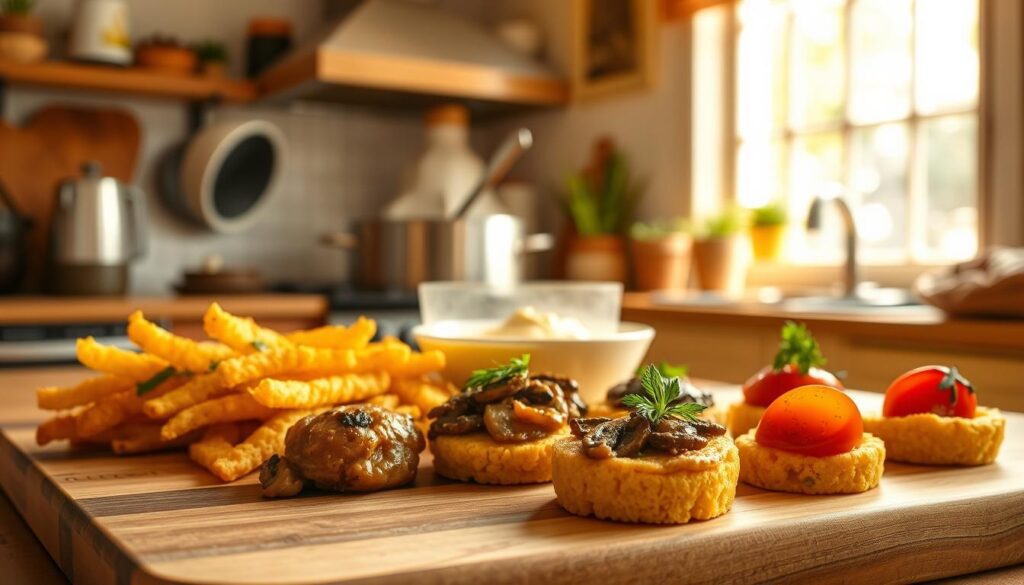
Conclusion and Final Thoughts
Exploring savory polenta is exciting. Try new toppings, spices, and veggies to make your breakfast bowls special. Each dish can show off your unique taste, making polenta recipes endless.
Sharing your polenta with friends and family brings happiness to your meals. Post your dishes online and share recipes. This way, you can inspire others to enjoy savory polenta too.
If you want to connect more with food, join the Savory Polenta Community online. It’s a place to meet others who love cooking. You’ll get new ideas and enjoy sharing your cooking adventures with like-minded people.

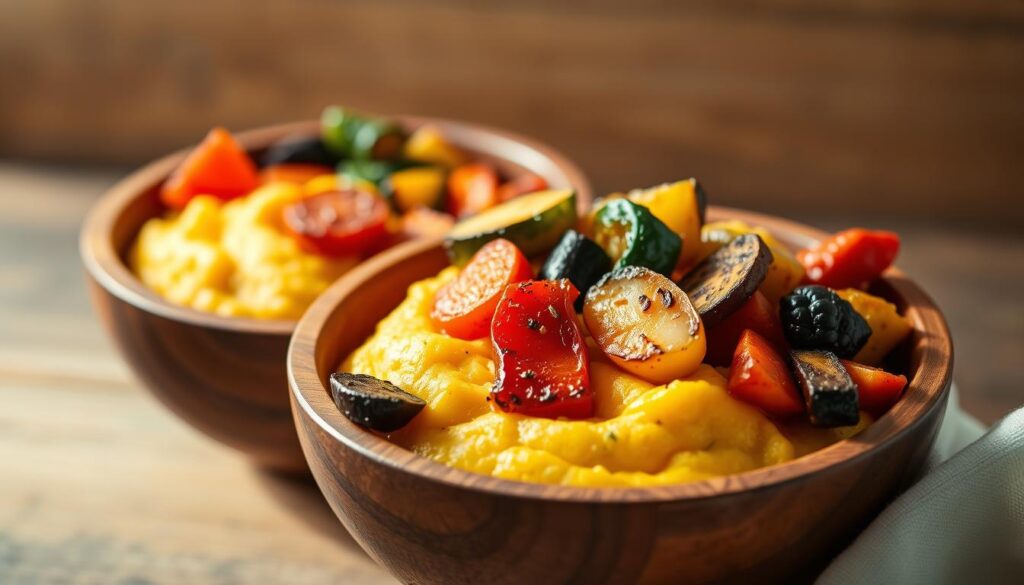
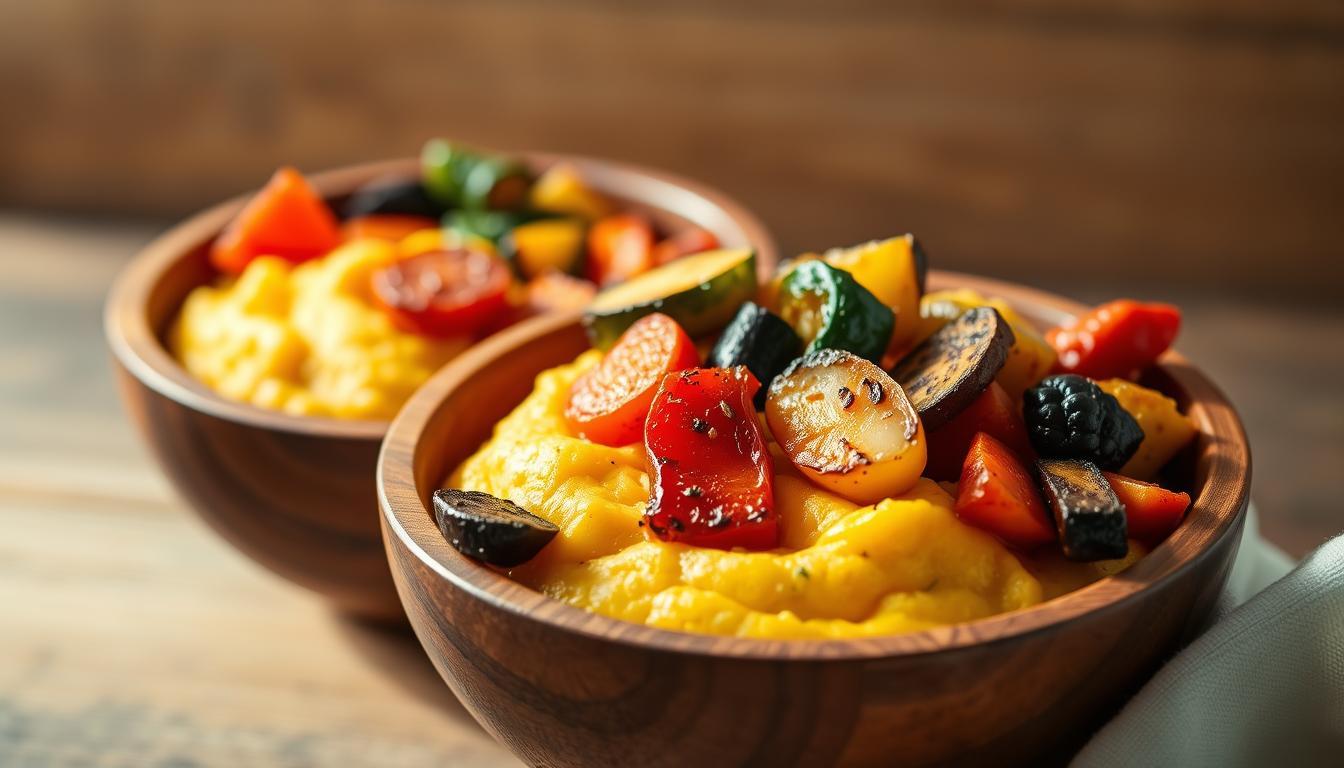
1 Comment